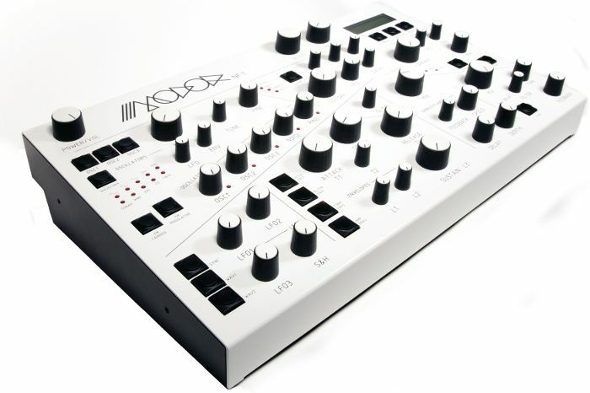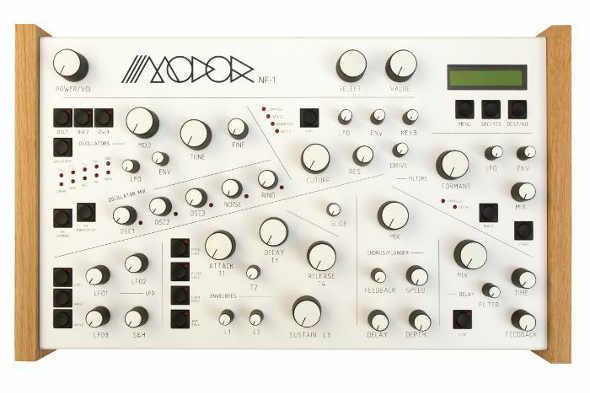Modor – NF1 Desktop Synthesizer

Robin Lee dives into Modor’s new-found world of digital synthesis aboard the Belgian manufacturer’s NF1.
The NF1 synth introduces a new player into the world of digital synth brands in the shape of Antwerp-based company Modor. With their feet firmly planted in the digital world, Modor have gone against the grain in championing digital sound over today’s fashionable analogue point of sale, while, all the more, retaining the kind of work flow you would find in any virtual analogue synth. This may be a digital machine, but the NF1 looks about as analogue as you can get, with the only hint this unit is in anyway digital coming from the small display that is tucked away in the top right corner.
Its white aluminium chassis is dotted with stylish knobs that have a multi-sided shaft design for a more luxurious finish, while the button designs give off an school veneer. The NF1 even comes with a set of wooden ears (pictured below) that you’ll need to install yourself. In use, the workflow is exactly what you would find on an analogue polyphonic synthesizer. There are three oscillators with the addition of a noise generator and ring modulator with the choice of ten wave types. Classic saw tooth, square and triangle shapes are joined by a sync emulation and additive harmonics simulation to add a level of aggression to the tonal palette. Sonar noise and wind noise are more obvious inclusions but more interestingly Modor have included an arcade noise source which has a very lo-fi 8-bit character; useful in adding a grungier edge to your sounds.
Finally the sound source department is wrapped up by an FM source and a feedback FM oscillator for some of your more refined digital signals. All of the sources can be personalised by using the Mod knob to change the pulse width or the harmonic focus of your chosen wave form, adding a level of depth to the sound designing process.
If the oscillators only merely hint at an analogue tradition, it’s in the filter that a more conventional design can be found. Classic low pass, high pass, band pass and notch are all available with cut off and resonance control. A quick sweep of the low pass filter reveals an incredibly smooth ride through the tonal landscape. It is possible to drive the filter but of course it is a digital kind of smearing rather than analogue grit that you will be hearing.
If you are looking for something a bit different in the filter area then you won’t be disappointed as Modor have included a formant filter that adds a level of organic scope to your patches. The formant filter gives you three vowel type shapes that can be modulated by any of the LFOs. You can use the digital menu to choose what kind of vowel shapes to use and this innovative feature really brings a freshness to the synthesis process and allows for some particularly interesting creations including the kind of electronic chanting tone that was previously only found in soft synths such as the Delay Lama.

Of course to shape your sounds Modor are relying on the tried and tested ADSR format, but they have included a control for changing the timing between the attack (A) and decay (D), and you can also change the level of the attack and sustain (S) parts of your shape. The layout of the ADSR is a little confusing as the sustain part is actually below the release (R) knob and there doesn’t seem to be an obvious reason why. Effectively there are four ADSR envelopes that can be used to shape the filter, formant, amp and pitch either individually or at the same time.
The modulation possibilities are really exciting with three LFOs and an additional stand-alone sample and hold shape. The only real challenge is in assigning the destinations for each source which is done by the slightly tedious menu diving process that blighted digital synthesis in the bad old days. Once you have navigated your way through the menus, however, there is a lot of scope for experimentation.
The other addition on the NF1 is the inclusion of built in digital effects, and yes, it struck me as an odd thing to include on a synth of this calibre. Built in digital effects blighted many digital workstations of the past, and it could be said that along with the proliferation of “impossible to navigate” editing menus, it is arguably the inclusion of sub-standard built in digital effects that sealed the fate of digital keyboards around the time of the mid-‘90s and early-‘00s. However, on this occasion Mordor have kept it simple with digital chorus and digital delay modules that are more than in keeping with its high grade finish.
You will find the chorus is completely under your command with tactile control over the amount, speed and feedback of the effect, allowing you to experiment with anything from subtle undulations to huge buzzing sweeps. You can use the sync function to get precise control over your delay type and yes the feedback will stretch the delay into cacophonous distortion if you wish.
High grade digital synthesis is starting to become popular. Yes, DSI’s highly regarded Prophet 12 relies on digital wavetable synthesis as does Roland’s Boutique line of reissues. Modor’s NF1 does something a bit different though. It doesn’t pretend to emulate the sound of an analogue synth. It can make very creamy waveforms that we associate with analogue, but with its formant filter, interesting palette of sound sources and those extended modulation functions, it’s possible to stretch your creativity into new territory. Is this another step on the road to digital synth recovery? More than likely.
More info/buy
Robin Lee